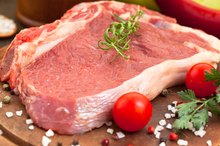Does Meat Contain Estrogen?
Most of the livestock in the United States are treated with synthetic hormones, and some consumers worry that the hormones provide excess estrogen in the American diet. However, this is a controversial subject with limited valid research on either side of the debate. Estrogen and other hormones do naturally occur in animal proteins and certain other foods.
Estrogen
Estrogen is a naturally occurring sex hormone found in males and females. The role of estrogen in men is not understood; however, estrogen is important in the female reproductive system. Estrogen production in women is responsible for the development of female sexual organs 2. Estrogen hormones help to facilitate menstruation and control other metabolic processes, such as bone growth and cholesterol levels. Too much estrogen has been linked to different cancers, including breast cancer and endometrial cancer.
- Estrogen is a naturally occurring sex hormone found in males and females.
- The role of estrogen in men is not understood; however, estrogen is important in the female reproductive system.
Synthetic Estrogen in Cattle
Are Hormones in Meat Affecting Humans?
Learn More
Growth-promoting hormones are implanted in most cattle in the United States. These hormones promote protein synthesis and result in cattle that are 10 to 30 percent larger than nontreated counterparts. Synthetic hormones in cattle mimic naturally occurring hormones in the animal. According to the University of Kentucky College of Agriculture, growth-promoting hormones used by the livestock industry have been extensively studied for safety and slight, if any, difference in hormones are noted in hormone-treated livestock 1.
- Growth-promoting hormones are implanted in most cattle in the United States.
Estrogen in Meat
Estrogen and other hormones occur naturally in livestock and can be found in small quantities in meat. The U.S. Department of Agriculture is unable to regulate the amount of growth hormones because it is impossible to differentiate the naturally occurring hormones from the synthetic type. However, the USDA does monitor meat from cattle for zeranol residues, a particular steroid hormone used to promote growth. Despite individual cases, it has not been scientifically proven that meat treated with hormones has any more estrogen than nontreated meat.
- Estrogen and other hormones occur naturally in livestock and can be found in small quantities in meat.
- However, the USDA does monitor meat from cattle for zeranol residues, a particular steroid hormone used to promote growth.
Red Meat and Breast Cancer Research
Do Growth Hormones in Food Affect Children?
Learn More
A major longitudinal study by Harvard Medical School and published in the “Archives of Internal Medicine” found that the consumption of red meat may be linked to breast cancer. Researchers followed 90,000 premenopausal women for 12 years. The participants who consumed the most red meat had nearly twice the risk of breast cancer as those who ate red meat infrequently. Although more research is needed, some researchers hypothesized that the growth hormones or naturally occurring hormones found in meat increased women’s estrogen production leading to breast cancer 2.
- A major longitudinal study by Harvard Medical School and published in the “Archives of Internal Medicine” found that the consumption of red meat may be linked to breast cancer.
- Although more research is needed, some researchers hypothesized that the growth hormones or naturally occurring hormones found in meat increased women’s estrogen production leading to breast cancer 2.
Related Articles
References
- University of Kentucky College of Agriculture; Growth-Promoting Implants for Beef Cattle; Jeff Lehmkuhler, et al.; March 2010
- Healthy Women; Estrogen; July 2011
- Gordon CM, Ackerman KE, Berga SL, et al. Functional Hypothalamic Amenorrhea: An Endocrine Society Clinical Practice Guideline. J Clin Endocrinol Metab. 2017;102(5):1413-1439. doi:10.1210/jc.2017-00131
- Fairview Health Services. Menopause: Effects of Low Estrogen Levels.
- Harvard Health Letter. An update on soy: It's just so-so. Published June 2010.
- Cleveland Clinic. Estrogen & Hormones. Updated April 29, 2019.
- Mayo Clinic. Hormone therapy: Is it right for you? Published May 24, 2018.
Writer Bio
Ireland Wolfe has been writing professionally since 2009, contributing to Toonari Post, Africana Online and Winzer Insurance. She obtained her Bachelor of Arts in psychology and Master of Arts in mental health counseling. She is also a licensed mental health counselor, registered nutritionist and yoga teacher.









